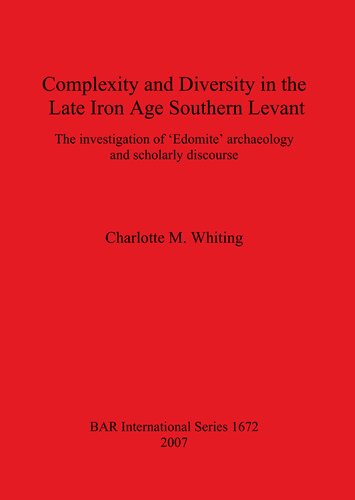

Most ebook files are in PDF format, so you can easily read them using various software such as Foxit Reader or directly on the Google Chrome browser.
Some ebook files are released by publishers in other formats such as .awz, .mobi, .epub, .fb2, etc. You may need to install specific software to read these formats on mobile/PC, such as Calibre.
Please read the tutorial at this link: https://ebookbell.com/faq
We offer FREE conversion to the popular formats you request; however, this may take some time. Therefore, right after payment, please email us, and we will try to provide the service as quickly as possible.
For some exceptional file formats or broken links (if any), please refrain from opening any disputes. Instead, email us first, and we will try to assist within a maximum of 6 hours.
EbookBell Team

4.1
20 reviewsThis study highlights a range of theoretical problems concerning Levantine Iron Age archaeology. Following the introduction, Chapter 2 provides the background for the study as a whole, tracing the archaeological study of the Iron Age southern Levant from the early nineteenth century to the present day. This highlights how and why archaeologists have changed their ideas about the narrative in question through time whilst also retaining a number of key ideas. Chapter 3 traces the archaeological study of 'Edomite' archaeology in the southern Levant in particular. Chapter 4 begins the critique of the key ideas and assumptions that underpin 'Edomite' archaeology by demonstrating that the individual historical sources used as evidence when discussing the 'Edomites' are not simply sources of factual information about the Iron Age. Chapter 5 takes a similarly critical approach to the methods of archaeological excavation, interpretation, and analysis used in south Levantine Iron Age archaeology. Chapter 6 completes the critique of the central ideas that form the basis of 'Edomite' archaeology by discussing the central tenets of archaeological theory concerning the relationship between material culture and identity that are required to support this idea. Chapter 7 outlines the methodology used in this study, which was designed to test whether specific ceramic types do in fact support the present interpretation of the late Iron Age southern Levant. The results of the analysis using this methodology are presented in Chapter 8. In Chapter 9 the implications of the preceding chapters are discussed and an interpretation of the evidence which does not rely on traditional problematic assumptions will be presented. Final conclusions are drawn in Chapter 10.